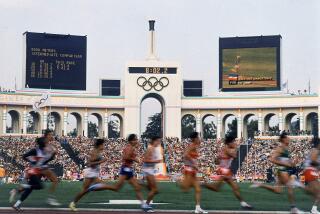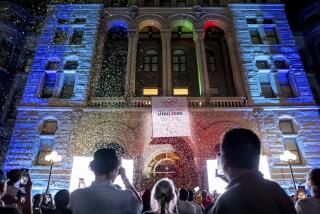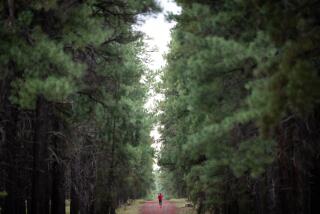Basking in Olympic Spirit
SALT LAKE CITY — It’s the kind of Olympic moment that might make viewers misty-eyed. The young shepherd boy with a dream, who learns to ski on the mountains of his troubled homeland, and who against all odds, arrives at the Winter Games to carry his nation’s flag into the Opening Ceremonies with tears running down his cheeks.
Except that slalom skier Bagher Kalhor is from the Islamic Republic of Iran, and his country’s been condemned by President Bush as part of an “axis of evil,” an enemy state sponsoring international terror.
Iraq and North Korea, the other “axis” states, didn’t send competitors to the Olympics, but Iran did, its first for a Winter Games in the United States. So far, the two athletes and their coaches have been greeted not as pariahs, but with the kind of warmth and curiosity previously reserved for cuddlesome underdogs like the Jamaican bobsled team.
“I can say that our reception has been the warmest possible. Everyone is curious to see what we are like and they see we are not terrorists but people of peace,” Eisa Saveh Shemshaki, president of the Iranian Ski Federation, said Wednesday.
While the popular image of Iran these days includes the masses screaming “Death to America,” as they did this week in a Tehran rally marking Iran’s revolutionary anniversary, Iran’s Olympic team exudes more party than Party of God. It speaks the international laid-back dude-speak, even translated from Farsi.
The handsome Kalhor, 22, dressed in black jeans and black sweater, said, “They ask some political questions, and I talk about the skiing and just say peace.” He smiled sleepily.
Asked his impression of America, Kalhor gave a thumbs up and said in English, “Excellent.”
When he’s not skiing the slalom, Kalhor said he hoped to take in the Salt Lake City and Park City sites and do some shopping. He has a fiancee back home, and he really did grow up tending his family’s flock of sheep. His twin brother, Sadegh, was also an accomplished skier, perhaps even more talented than Bagher, but he lost his lower leg in a skiing accident five years ago; Sadegh will compete in the Paralympics here this month.
The delegation had only one official requirement, that the federal government waive its usual practice of fingerprinting and photographing all Iranians visiting the United States, a procedure the Iranian government considers insulting. The Bush administration waived the requirement.
The entourage said they moved through immigration and customs in Chicago with ease. “They just swept us through,” said Morteza Saveh Shemshaki, the cross-country ski coach. “No problem. Welcome to America. Have a nice day.”
In fact, the only person who seemed not entirely pleased by their arrival was President Bush, who was shown on television sitting stone-faced when the Iranians entered the Opening Ceremonies, though the crowd gave them a big round of applause.
The small delegation, decked out in blue and white parkas with “IRAN” emblazoned on the back, don’t come across as indoctrinated tools of Iranian propaganda. Far from emoting hostility, the coaches remind their visitor: “Do not forget, there are six incredible ski areas just outside of Tehran. Next time you come to Iran, bring your skis.”
The young athletes roll their eyes when asked about the political ramifications of their visit here, but their coaches are happy to deal more directly with the question.
They say that Bush is wrong, that Iran isn’t evil and doesn’t condone terrorism, that its government is democratically elected, and that Iran wants to be appreciated as a member of the world community, not a rogue state.
The athletes and coaches, though semi-officials of the Iranian government, say they’re not here as apparatchiks, but from extended athletic dynasties, representing several interrelated families who hail from two mountain towns, Dizin and Shamshak, where downhill sports are centered in Iran.
“People are always surprised to learn we have big, snowy mountains,” said head coach Majid Seghatoleslami, who divides his time between Tehran and Park City, Utah. “But we have gorgeous mountains.”
Shamshak was developed by European engineers. Locals watched the foreigners skiing, and slapped boards on their feet and used saplings as poles and picked up the sport. During the 1970s, Iranians became relatively accomplished on the slopes, and the ousted Shah and his family often skied.
But religious revolution in 1979, the hostage-taking at the American embassy in Tehran and the war with Iraq that followed derailed winter sports in Iran. “There wasn’t the fuel to run the lifts or to drive your cars to the mountains,” said Seghatoleslami.
Asked whether religious authorities frown on skiing, or consider it decadent or too Western, the head coach said no. “Every Friday in Iran, the slopes are crowded with skiers,” he said.
On Friday, Mostafa Seyed Mirhashemi skied in his one and only event, the men’s cross-country pursuit, a two-race event. His starting position in the 10-kilometer classical portion was dead last. His overall finish: 79th of 85 competitors, not good enough to move on to the 10k freestyle portion.
But his teammates were impressed to see that in the land of the Great Satan, the crowd rang cow bells and hooted and some even shouted, “Go Iran!”
More to Read
Go beyond the scoreboard
Get the latest on L.A.'s teams in the daily Sports Report newsletter.
You may occasionally receive promotional content from the Los Angeles Times.








